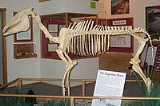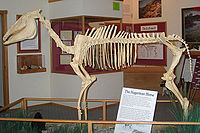
Plesippus
Encyclopedia
Plesippus is often considered an intermediary stage between Dinohippus and the present day genus, Equus.
 The famous fossils found near Hagerman, Idaho were originally thought to be a part of the genus Plesippus Hagerman Fossil Beds
The famous fossils found near Hagerman, Idaho were originally thought to be a part of the genus Plesippus Hagerman Fossil Beds
(Idaho), a Pliocene site, dating about 3.5 Ma ago. The fossilized remains were originally called Plesippus shoshonensis but further study by paleontologists determined that fossils represented the oldest remains of the genus Equus. Their estimated average weight was 425 kg, roughly the size of an Arabian horse
.
At the end of the Pliocene, the climate in North America began to cool down significantly and most of the animals were forced to move south. One group of the Plesippus species moved across the land bridge around the Bering Strait
into Eurasia around 2.5 Ma ago.

Hagerman Fossil Beds National Monument
Hagerman Fossil Beds National Monument near Hagerman, Idaho, contains the largest concentration of Hagerman Horse fossils in North America. The fossil horses for which the Monument is famous have been found in only one locale in the northern portion of the Monument called the Hagerman Horse Quarry...
(Idaho), a Pliocene site, dating about 3.5 Ma ago. The fossilized remains were originally called Plesippus shoshonensis but further study by paleontologists determined that fossils represented the oldest remains of the genus Equus. Their estimated average weight was 425 kg, roughly the size of an Arabian horse
Arabian horse
The Arabian or Arab horse is a breed of horse that originated on the Arabian Peninsula. With a distinctive head shape and high tail carriage, the Arabian is one of the most easily recognizable horse breeds in the world. It is also one of the oldest breeds, with archaeological evidence of horses...
.
At the end of the Pliocene, the climate in North America began to cool down significantly and most of the animals were forced to move south. One group of the Plesippus species moved across the land bridge around the Bering Strait
Bering Strait
The Bering Strait , known to natives as Imakpik, is a sea strait between Cape Dezhnev, Chukotka Autonomous Okrug, Russia, the easternmost point of the Asian continent and Cape Prince of Wales, Alaska, USA, the westernmost point of the North American continent, with latitude of about 65°40'N,...
into Eurasia around 2.5 Ma ago.

